
In the Media: Mindfood
A lap of luxury
A seaplane transports guests to splendid comfort afloat in Tasmania’s wild far south-west, then up and across to an exclusive lodge on the island’s east coast. Along the way there are gentle connections, stark contrasts and an abundance of glorious scenery and gourmet delights.
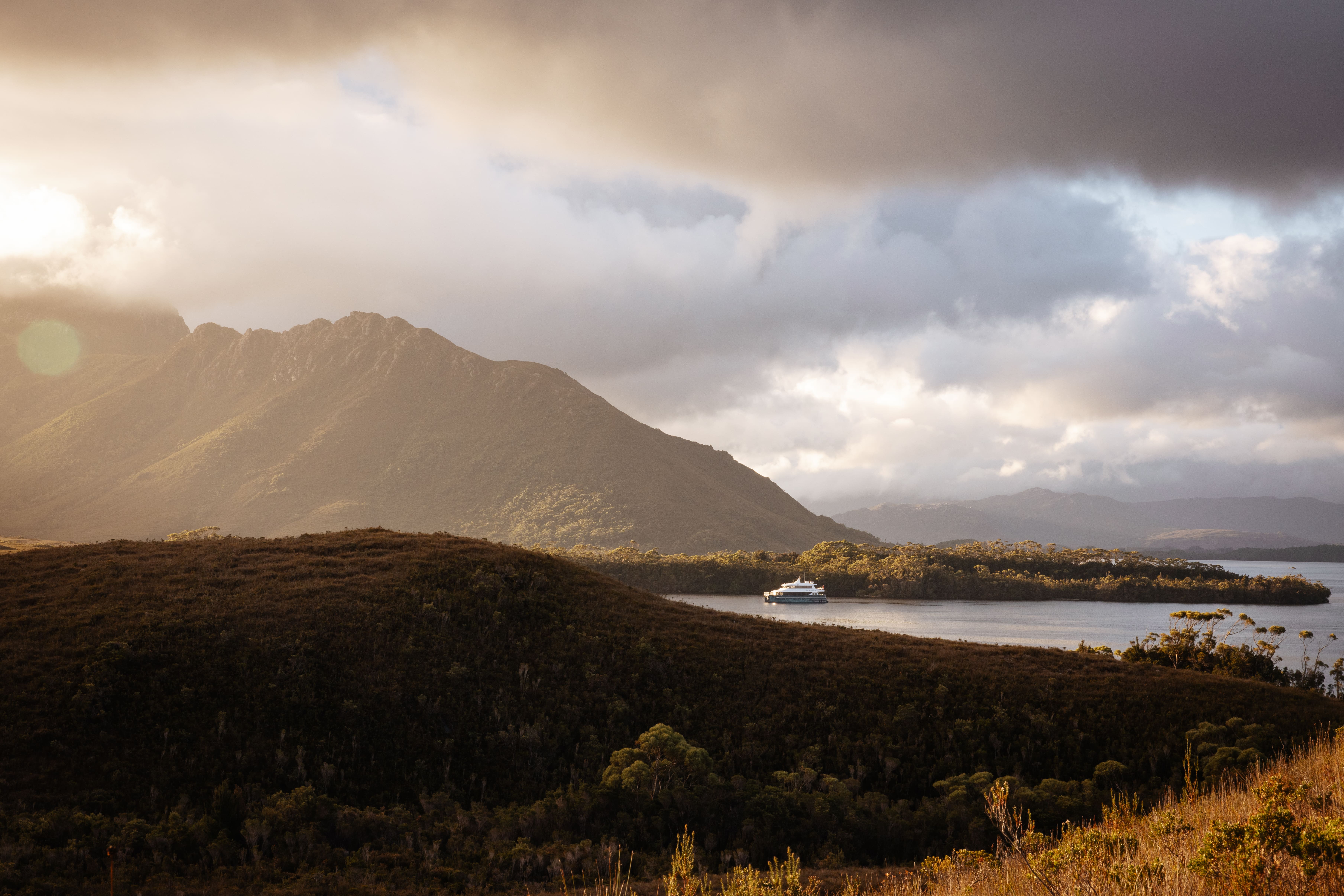
Image: Lean Timms
We’re bobbing about in an aluminium dinghy in the Southern Ocean off the south-west coast of Tasmania. Guide Jimmy Emms points to the jagged seaward side of the Breaksea Islands, weather-battered by the timeless smashing of icy ocean into their quartzite cliffs. “You can see the immense value of these islands to mariners,” says Emms. He has motored the tinnie around from the leeward side, where lush vegetation valiantly clings to the rocky islands. The Breakseas at the entrance of Port Davey make this port in a storm, the shelter of Bathurst Harbour further in. We skid smoothly down a wave back inside of the islands and onto the warm comforts of Odalisque III, the flagship vessel of On Board Expeditions.
Days later, we skim across the aquamarine waters in Above & Beyond’s Cessna Caravan to land on Great Oyster Bay. The same seaplane that flew us down to the UNESCO Tasmanian Wilderness World Heritage Area of Port Davey delivers us to the Freycinet Peninsula and the lap of landlubbing luxury at Saffire, the east coast’s famous resort.
On Board and Saffire have partnered to create Coast-to-Coast Luxury, the ultimate Tasmanian expedition. It’s a heady blend of nature, wildlife, history and culture across the sea, sky and land of Australia’s island state. Here are some of my highlights.
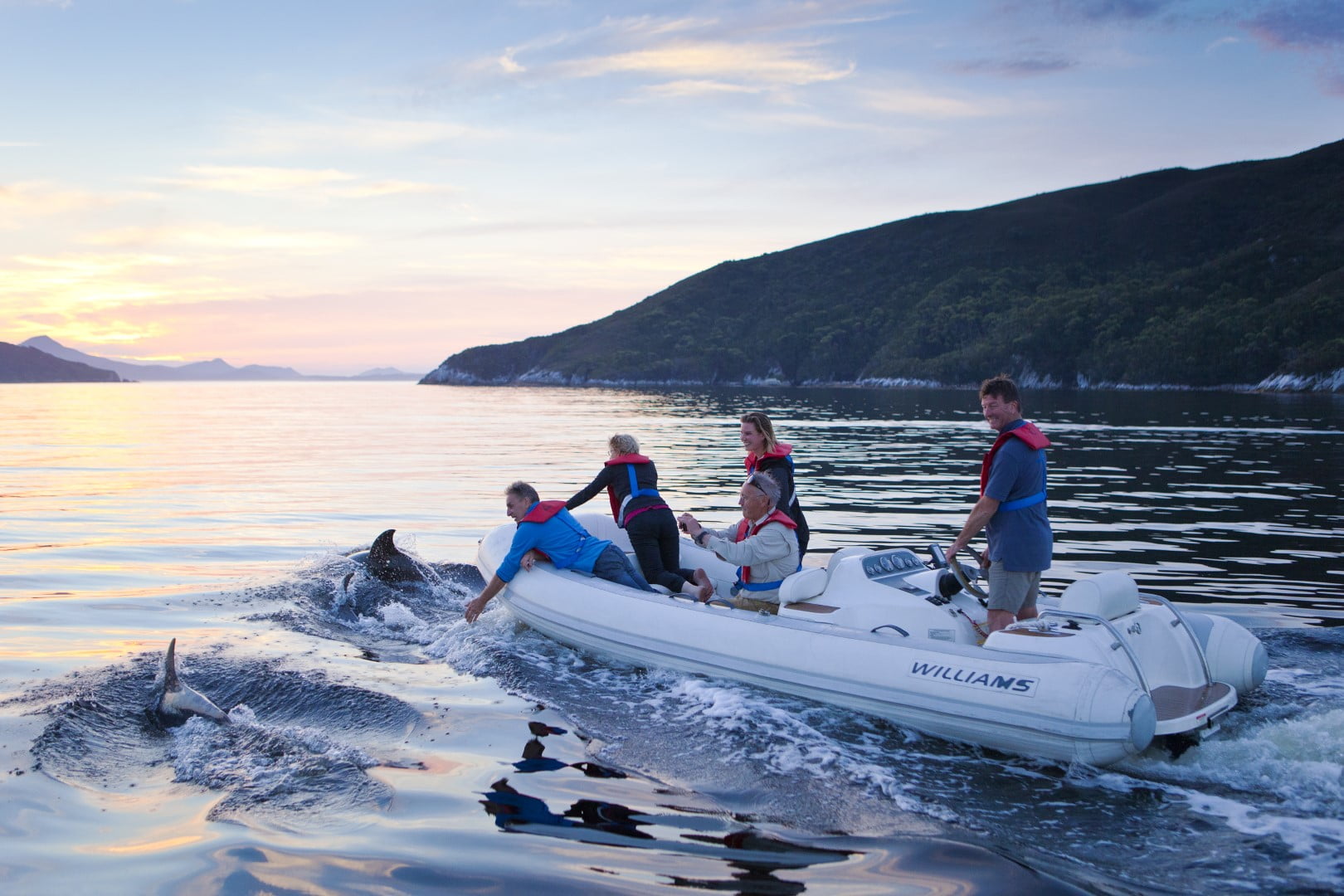
Image: Mark Daffey
Movie-star arrivals
There’s a frisson of James Bond arriving by seaplane within swimming distance of your vessel or wading distance of a golden beach. The three flights connecting Hobart, the coastal escapes and back to the city fly low and slow across Tasmania’s rugged landscape. After boarding in Constitution Dock – a two-minute walk from our overnight stay at MACq 1 – we fly south on the calmest and clearest of days, looking out to Bruny Island and over Federation Peak before landing near Bathurst Harbour’s Celery Tops Island where Odalisque III waits on her mooring. Pilot Lee Haskell kisses the floats of the seaplane on the glassy surface of the water so gently that it’s hard to discern when we’ve actually touched down.
There are a few bumps in the clouds when a few days later we fly up and across to Freycinet Peninsula, but the majesty of the view holds true and soon we’re within sight of the pink granite of The Hazards as we fly past the famous scoop of Wineglass Bay. A few steps through warm water and we’re ashore and into Saffire’s waiting minibus.
The Licence to Thrill seaplane caper is the perfect fit for the luxury cruiser and the exclusive resort.

Go wild without roughing it
This remote corner of Tasmania is the traditional home of the Needwonnee people and there is also a rich history of pioneering white Australians. Over three summers in the 1950s, tin miner and naturalist Deny King carved out the gleaming white airstrip at Melaleuca after marrying Margaret Cadell – when their daughters were born she wanted a quicker way in and out of the wilderness. To this day, there’s no road in, but there is a wonderful heritage museum and well-preserved buildings at Melaleuca, which is also home to the breeding grounds of the endangered orange-bellied parrot (aka the OBP).
There’s a vast gulf between the way the mining and fishing families survived down here and life aboard Odalisque III. The Tasmanian-built 24-metre catamaran was christened in 2023 and has been purpose-built to cruise softly, as it must inside Port Davey Marine Park. There are spacious lounges on both decks and a bar with Tasmanian craft beers and ciders on tap and cleverly configured indoor and outdoor dining options.
Magnificent scenery pours in from enormous picture windows in the six guest cabins, which each have their own private ensuite and AC controls, amenities from small Hobart skin-care company Milie Organics, and a dangerously comfy queen bed. The decor echoes the south-west’s muted greens and russets. Each night, skipper Matt Shepperd shuts down the generator and all is silent apart from the gentle lapping of water on the hull. Bright starlight illuminates shadowy cut-outs of various nearby peaks and the Western Arthurs encircling us.
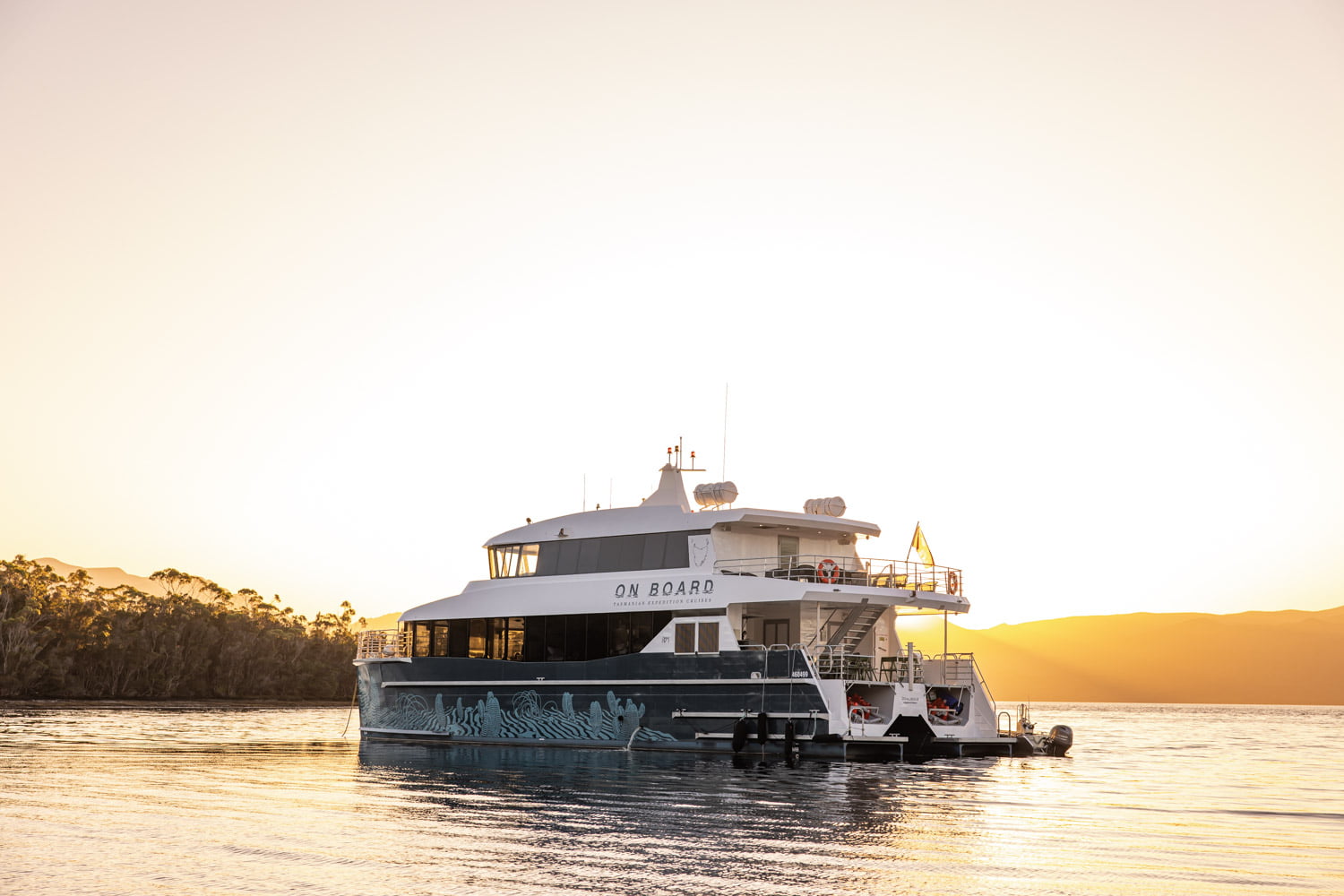
South-west: tastings and tinnies
We get a couple of days of glorious weather followed by the south-west’s trademark wind and rain. When venturing out in Odalisque III’s sturdy tinnies in a squall we are given enormous blue waterproof ponchos and hot-water bottles snuggled in knitted woollen covers. We hunker down in the tinny’s bucket seats and lean into the adventure and the driving rain. On our return, the crew – Jess Cooper and Bonnie Hesketh – whisk away our wet shoes to the drying cupboard and get busy making hot drinks.
Head chef Courtney Drew is tireless in the galley, presenting us with local fare such as perfectly barbecued east coast rock lobster and Cape Grim hanger steak with saltbush, caper and herb butter. After one afternoon walk we’re met on the beach with a pop-up sundowner bar. Last Sanctuary Tasmanian organic gin and tonics and Arras sparkling are served with Bruny Island oysters, pickled octopus and scallops on the shell with wakame. On the afternoon of our outside-the-Breakseas adventure Jess and Courtney treat us to a cheese and wine tasting on the top deck as sunset gathers for a grand light show.
The boat’s green-glazed tableware, vases and art all come from Tasmanian makers and creators – shoutout to the best pepper grinder ever made by Simon from Tassie Timber Things! Courtney caters without fuss for a range of guest dietaries and strongly supports On Board’s charismatic founder Pieter van der Woude’s decree that no farmed Tasmanian salmon may be served on his boats.
We alternate between eating and drinking and exploring out in the tinnies and along the tracks with Jimmy and Matt. On one walk for a marvellous view over Bathurst Harbour there’s so much wombat poo that I expect to see an army of the blocky little natives marching out from the buttongrass. Heading up Mt Milner we follow a track scattered with jagged, gleaming lumps of quartzite – a hallmark of the local geology. A swim in Bramble Cove afterwards is a refreshing reward for my gentle climb (the more energetic in our group are tackling the steeper slopes of Mt Stokes). We even get a glimpse of a few rare OBPs in flight near the old tin mines.
On our final morning we take the dinghies up the Old River for glassy reflections of the bush and sky, cutting the outboards to drift in silence. Jimmy, who’s a photographer by trade, says it’s a parade of classic Tasmanian wilderness flora – buttongrass, wet sclerophyll forests and rainforest, downstream from wild rivers. We don’t spot an Azure kingfisher today – the Tasmanian population is critically endangered and On Board is helping to track sightings of it as part of a citizen science project. The wheeling pairs of white-bellied sea eagles and flocks of black swans keep the birdwatchers among us happy. Even without them, being in this pristine wilderness is a privilege in itself.
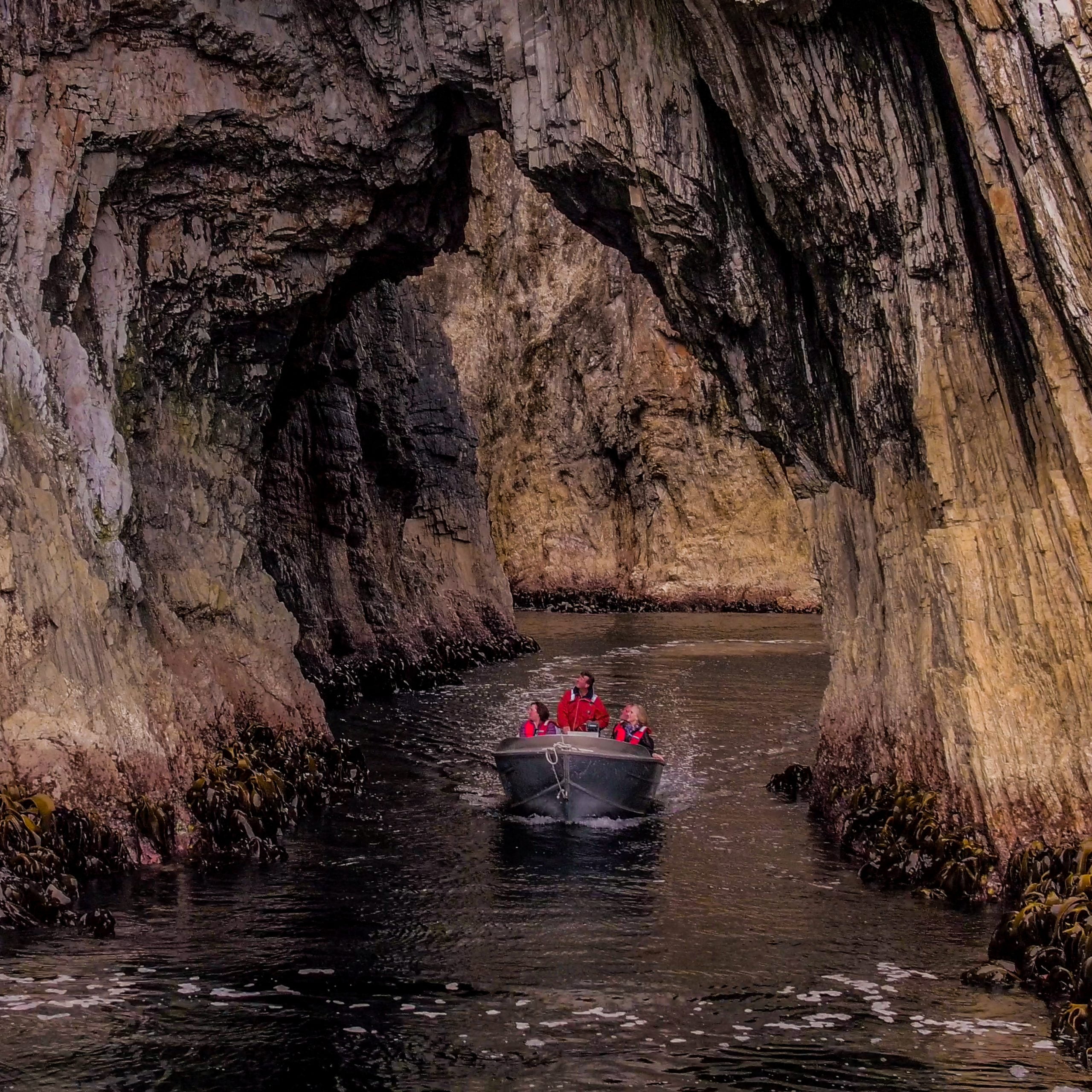
East: flora, fauna and fine dining
After that glam beach landing it seems almost like magic that we’re on the sunny Freycinet Peninsula for the second half of our trip, ensconced in style at Saffire. The resort’s unique architecture captured imaginations when it opened in 2010. “It’s designed to look like a southern eagle ray, which is found here in Great Oyster Bay,” Saffire’s guide manager Hamish Cunningham tells us as we look back to Saffire from the Wineglass Bay track. “In aerial shots of the property, it looks like a stingray descending to the bay.”
All of Saffire’s 20 enormous suites look across that bay to the ever-changing light show on The Hazards. Each is completely private from its neighbours with the same sweeping outlook. Contemporary Tasmanian furnishings sit comfortably alongside mid-century greats – such as Eames-designed chairs – and the outside is cleverly brought in via natural materials throughout the buildings, with the vista ever-present through the curved windows of the main pavilion.
Saffire is renowned for its fine dining and the fact that you can only eat here when you’re staying here makes Palate one of the most exclusive restaurants in the land. It is also alive with birds (a fairy wren watches me eat breakfast), bees and Tasmanian devils.
Among the many included experiences is seeing the resident devils devour half a wallaby. These devils are retired breeders living out their days in luxury in a one-hectare enclosure. Aged around seven they’re considered old but they’re loud and feisty as guide Nicole Dyble – aka the Devil Queen – chains up the marsupial carcass for their dinner. Dyble fills us in on devil behaviour and why conserving them is so vital for the ecosystem. Witnessing the gorging – blessedly on the other side of a giant viewing window – doesn’t cause any of us to skip a beat when it comes to our own evening meal.
Dinner at Palate is a choice of a la carte or the night’s five-course tasting menu, with paired wines and an option to pay extra to level-up (the included wines are all top-shelf, so not sure why you’d bother). On our first night, the tasting menu includes yellowtail kingfish with pickled nectarine and coconut yoghurt, slow-cooked onion with macadamia cream, buckwheat and oregano, Mooloolaba king prawns with native curry and local sea succulents, a 21-day dry-aged lamb tomahawk served with garlic and parsley from Saffire’s kitchen garden and blood-orange granita with a citrus almond crumb to finish. It’s every bit as wonderful as it sounds.
We’re thinking more about the full life cycle of our food after an afternoon with Rob “The Bee Man” Barker, a horticulturist and apiarist who keeps hives – and a whole heap of full-body beekeeper suits – at Saffire. The hands-on bee-keeping experience culminates with a honey tasting. Rob is generous with his knowledge, gentle with his bees and has us in stitches with his jokes. (Sample quip: a drone bee’s sex organ “is also a common unit of measurement among tradies…”. I suspect it went over the heads of international guests.) We all leave the experience with even greater wonder for the secret lives of bees – and selfies looking like astronauts in the apiarist suits.

Muscling in on molluscs
The dishes coming from executive chef Paddy Prenter’s kitchen team to the tables at Palate are all delicious works of art. There two that I would walk over a Tassie devil for are Fraser Island spanner crab scramble on a buckwheat pancake with Avruga caviar and crème fraiche at breakfast and the local Pacific oysters, served simply yet spectacularly on a bed of tiny shells.
Hamish and fellow guide Ashlee Ugle take us out for Saffire’s signature oyster experience at Freycinet Marine Farm, where we slurp freshly shucked beauties back standing in waders at a table in the middle of the lease. The resort spreads the love by sourcing molluscs for Palate from Melshell Oysters, the other family-owned farm on Great Oyster Bay. We happily consume dozens – after all we’re on the lands of the Oyster Bay people.
Over the years I’ve been fortunate to meet several First Nations people who’ve shared their stories and knowledge with me. Walking through the bush and along the beach with Indigenous artist and guide Mick Quilliam is one of the most absorbing and moving experiences I’ve had. When we come across a spray of beautiful shells on the tideline Mick explains how shells left behind on campfires showed the tribes travelling through what to take and what to leave, thereby managing the seafood stocks sustainably. “If you saw limpet shells arranged on the coals, the next group would say, ‘Oh, they had limpets, so we’ll have scallops’,” says Mick. “The next group would have oysters, the next green-lipped abalone, the next black-lipped, and so on.”
Tools, stones, photos, documents and more appear from his voluminous backpack to help bring the cultural practices he’s explaining to us to life. On the beach, he brings out mini dampers to dip in sweet cider gum sap from his own 250-year-old tree above the snowline in Tasmania. These endemic Miena cider gums have deep significance to the palawa – Tasmania’s First Nations people – and are in danger of dying out. “We go with friends up each November and harvest it using traditional methods, and we only ever take three litres a year,” says Mick.
Walking with Mick encapsulates this Coast to Coast Luxury trip. Some of the most precious parts of our country and its heritage have been shared with us. Yes, I feel pampered and treated and full of many fascinating experiences and delicious meals, but more than that this Tasmanian odyssey has filled my heart.
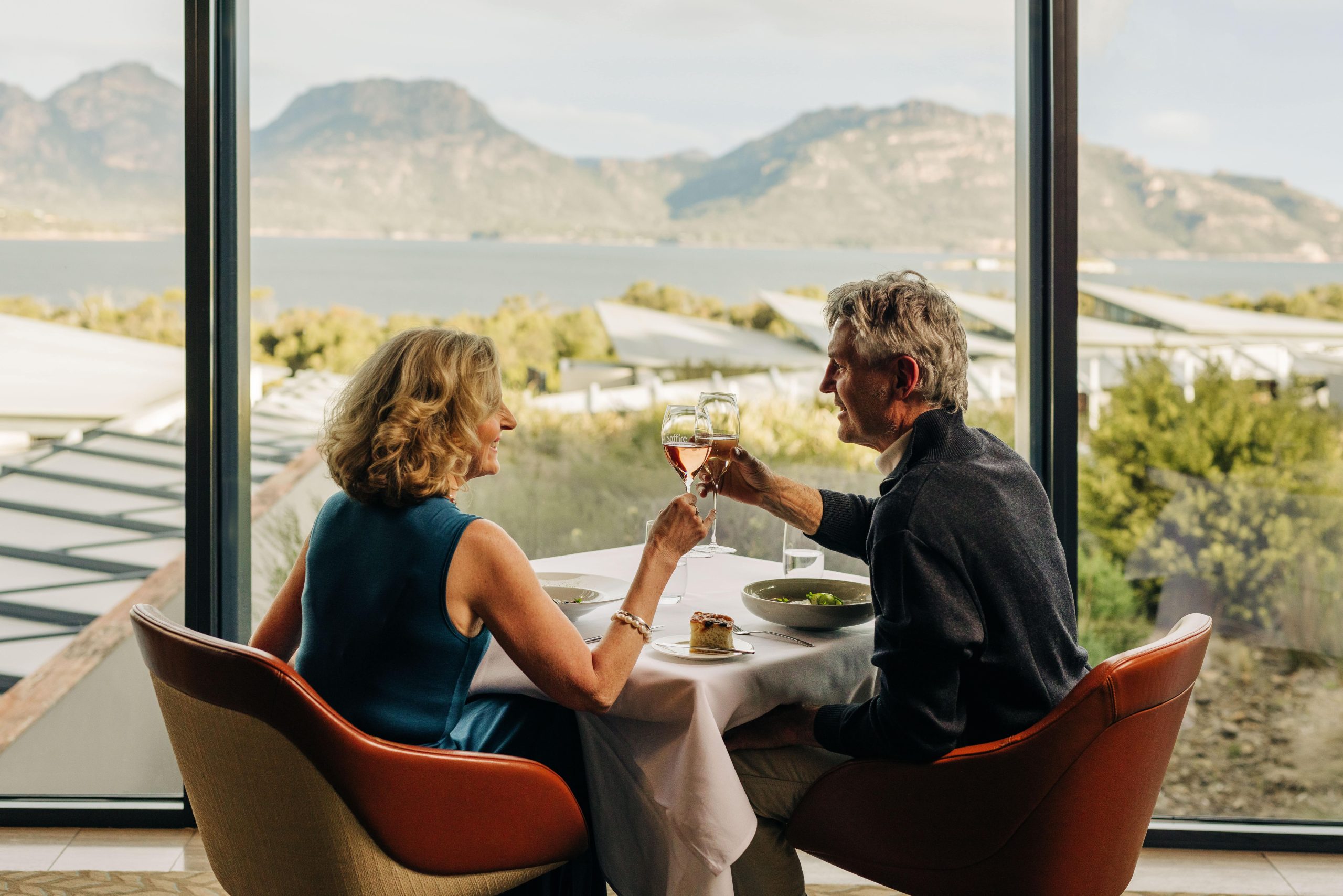
Getting there
Meet your Above and Beyond seaplane at Constitution Dock in Hobart to begin the Coast to Coast Luxury experience. Departures March 29, May 4 and December 7 2024. Each of the six-night departures can accommodate only six couples.
Written by Jane Nicholls for Mindfood, April 2024
